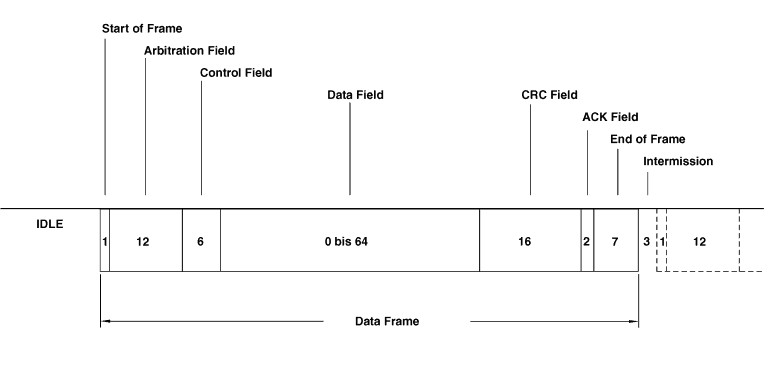
| GF54.00-P-0005-01A | CAN data bus data telegram | all |  |
During normal operation, messages consist of the following transfer frames:
 Data frame Data framefor transmitting CAN messages (such as coolant temperature, etc.).  Remote frame Remote frame for requesting CAN data from a different control unit.  Error frame Error frameinforms all connected control units that an error has occured and that the most recent CAN message is invalid. |
The CAN protocol supports two different data frame formats, with the only difference residing in the length of the identifier:
- Standard format - Expanded format Only the standard format is currently in use at DaimlerChrysler. |
 |
| P54.00-1037-09 |
The data telegram for transmitting CAN messages through the CAN data bus consists of seven sequential blocks:
 Start of frame: indicates the start of the CAN message Start of frame: indicates the start of the CAN message
(Start bit) and synchronizes all stations.  Arbitration field: This field consists of the identifier Arbitration field: This field consists of the identifier
(identifier and) (address) with 11 bits and one control bit request) (remote transmission request bit). This control bit indicates if the message contains a data frame or a remote frame without bytes.  Control field: The control field (6 bits) contains the IDE bit (identifier extension bit) to distinguish Control field: The control field (6 bits) contains the IDE bit (identifier extension bit) to distinguish
(control bits) between the standard and expanded format, a reserved bit for future expansions and the number of bytes contained in the data field in the last 4 bits. |
 Data field: The data field can contain between 0 and Data field: The data field can contain between 0 and
(data) 8 bytes of data. A CAN message with a length of 0 can be employed to synchronize distributed processes.  CRC field: The CRC field (cyclic redundancy CRC field: The CRC field (cyclic redundancy
(check field) check field) consists of 16 bits and is used to detect transmission errors.  ACK field: The ACK field (acknowledgment field) ACK field: The ACK field (acknowledgment field)
(receipt contains a confirmation signal from all confirmation) receivers that have received the CAN message without error.  End of frame: Marks the end of the message. End of frame: Marks the end of the message.
(frame end) |
 Intermission: The interval between two messages. Intermission: The interval between two messages.
(Intermission) The interval must contain at least 3 bits. The next message can then be sent by any control module. |
 IDLE: If none of the control modules transfer data, the IDLE: If none of the control modules transfer data, the
(idle) CAN data bus remains idle until the next message is sent. |